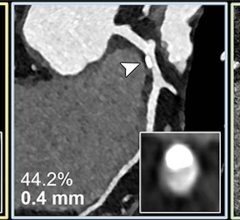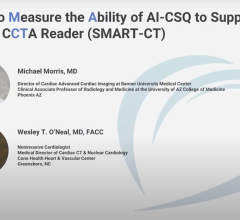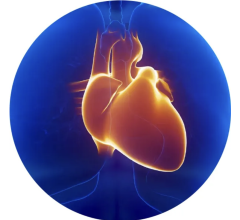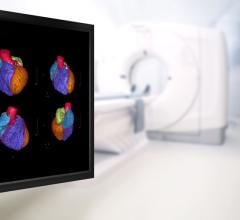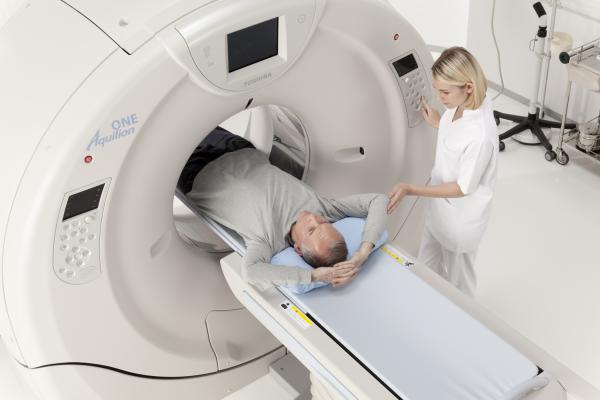
March 24, 2014 — Computed tomography (CT) imaging utilization has grown markedly across many clinical disciplines during the past decade, raising concerns about radiation overexposure. Some estimates suggest CT imaging now accounts for about half of all U.S. medical imaging procedures that expose patients to ionizing radiation; CT angiography composed about two-thirds of the estimated 81.9 million CT exams performed in the United States in 2010. A CT system’s ability to reduce radiation dose has largely become the new hallmark feature.
Strategies for Reducing Radiation Dose
Strategies typically rely on one or more of the following: software algorithms used for image reconstruction after the CT exam, technology used during scanning, changes in scanning protocols, and shields used to protect vulnerable organs or tissues that are not of clinical interest in the image capture area.
Additionally, iterative reconstruction (IR) uses new algorithms to process and reconstruct raw CT image data in a more computer-intensive approach than the standard back-projection techniques. These techniques aim to reduce the amount of noise in the reconstructed images without affecting the contrast, thereby enabling the use of lower radiation doses without sacrificing image quality. It is routinely used in nuclear medicine; however, the level of computing power and speed required to make it clinically feasible in CT were previously unavailable.
Eliminating Overscanning
In any helical CT scan, tissue outside the targeted volume is exposed to unnecessary radiation (known as overscanning or overbeaming) because all CT exams must start and finish the scan outside the planned volume. To address the overscanning problem, some manufacturers have integrated sliding collimators that automatically shape or narrow the beam to match the scanning volume. According to manufacturers, the sliding collimators reduce the radiation dose without affecting image quality and require no additional input from the system operator. Dose savings will depend on the scanning volume, pitch (i.e., speed at which the patient table moves through the scanner), and CT detector width.
Organ-specific Dose Reduction
Certain organs are more susceptible to radiation damage. During a CT scan, most of the dose is delivered when the X-ray tube is closest to the target organ. Therefore, if the X-ray tube output is momentarily reduced as it rotates past sensitive tissues, the radiation dose could be reduced to superficial tissue. One manufacturer offers an option intended to substantially reduce the dose over specific regions (e.g., thyroid, breasts). Organ-specific dose reduction is unlikely to significantly affect overall image quality, and the overall dose will not be reduced; however, the dose savings to specific organs can be significant.
Patient Safety Issues
In response to reports of excessive radiation, in 2010 U.S. Food and Drug Administration (FDA) gave hospitals several recommendations to improve patient safety during CT perfusion scans, including the following:
- Assess whether any of your patients received excess radiation during CT perfusion scans.
- Review your radiation dosing protocols for all CT perfusion scans to ensure that the correct dosing is planned for each study.
- Implement quality control procedures to ensure that dosing protocols are followed every time and the planned amount of radiation is administered.
- Check the display panel before performing each scan to make sure the amount of radiation to be delivered is at the appropriate level for the individual patient.
- If more than one study is performed on a patient during one imaging session, adjust the dose of radiation so it is appropriate for each study.
Cost Issues
The most advanced radiation-dose-reduction capabilities were originally available on only high-end CT systems. According to ECRI Institute’s PricePaid database, these high-end CT systems have list prices ranging from about $1.2 million to $4.5 million (as of September 18, 2013), depending on the model and configuration, although quoted prices may be substantially lower. Midrange CT systems, which feature 64 channels and 64 slices and might be upgradable to receive advanced dose-reduction technology, have list prices ranging from about $895,000 to $2.7 million, depending on model and configuration, although quoted prices may be lower. Adding IR capability to an existing CT scanner that can accommodate the change can cost from $100,000 to $150,000 and requires a significant computer upgrade to meet the demands for greater processing power, and new software.
Timing of Diffusion
Over time, we expect that more hospitals and imaging centers will adopt advanced dose-reduction technology as they replace older CT systems, and many of these features will likely become more affordable standard features on lower- and midrange systems, as well as high-end CT systems. According to ECRI Institute’s SELECT group, which collects data on hospital procurement trends and equipment pricing, data showed an increasing interest in high-end or premium CT systems from 11 percent in 2008 to 31 percent in 2011. The increased interest in high-end CT systems appeared to have affected interest in midrange CT systems, for which interest dropped from 69 percent in 2008 to 45 percent in 2011.
For more information: www.ecri.org/Forms/Pages/CT_Radiation_Dose_Safety_Resources.aspx


 March 20, 2024
March 20, 2024 
